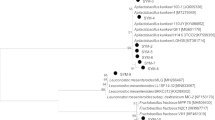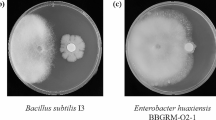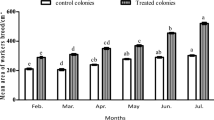Abstract
The purpose of this article is to reveal the role of the lactic acid bacteria (LAB) in the beebread transformation/preservation, biochemical properties of 25 honeybee endogenous LAB strains, particularly: antifungal, proteolytic, and amylolytic activities putatively expressed in the beebread environment have been studied. Seventeen fungal strains isolated from beebread samples were identified and checked for their ability to grow on simulated beebread substrate (SBS) and then used to study mycotic propagation in the presence of LAB. Fungal strains identified as Aspergillus niger (Po1), Candida sp. (BB01), and Z. rouxii (BB02) were able to grow on SBS. Their growth was partly inhibited when co-cultured with the endogenous honeybee LAB strains studied. No proteolytic or amylolytic activities of the studied LAB were detected using pollen, casein starch based media as substrates. These findings suggest that some honeybee LAB symbionts are involved in maintaining a safe microbiological state in the host honeybee colonies by inhibiting beebread mycotic contaminations, starch, and protein predigestion in beebread by LAB is less probable. Honeybee endogenous LAB use pollen as a growth substrate and in the same time restricts fungal propagation, thus showing host beneficial action preserving larval food. This study also can have an impact on development of novel methods of pollen preservation and its processing as a food ingredient.



Similar content being viewed by others
References
Keller I, Fluri P, Imdorf A (2005) Pollen nutrition and colony development in honey bees: part I. Bee World 86(1):3–10. https://doi.org/10.1080/0005772X.2005.11099641
Anderson KE, Carroll MJ, Sheehan T, Lanan MC, Mott BM, Maes P, Corby-Harris V (2014) Hive-stored pollen of honey bees: many lines of evidence are consistent with pollen preservation, not nutrient conversion. Mol Ecol 23(23):5904–5917. https://doi.org/10.1111/mec.12966
Allen MD, Jeffree EP (1956) The influence of stored pollen and of colony size on the brood rearing of honeybees. Ann Appl Biol 44(4):649–656. https://doi.org/10.1111/j.1744-7348.1956.tb02164.x
Mattila HR, Otis GW (2006) Influence of pollen diet in spring on development of honey bee (Hymenoptera: Apidae) colonies. J Econ Entomol 99(3):604–613. https://doi.org/10.1603/0022-0493-99.3.604
Campos MGR, Bogdanov S, de Almeida-Muradian LB, Szczesna T, Mancebo Y, Frigerio C, Ferreira F (2008) Pollen composition and standardisation of analytical methods. J Apic Res 47(2):154–161. https://doi.org/10.3896/IBRA.1.47.2.12
Gilliam M (1979) Microbiology of pollen and bee bread: the genus Bacillus. Apidologie 10(3):269–274. https://doi.org/10.1051/apido:19790304
Mattila HR, Rios D, Walker-Sperling VE, Roeselers G, Newton ILG (2012) Characterization of the active microbiotas associated with honey bees reveals healthier and broader communities when colonies are genetically diverse. PLoS One 7(3):e32962. https://doi.org/10.1371/journal.pone.0032962
Vásquez A, Forsgren E, Fries I, Paxton RJ, Flaberg E, Szekely L, Olofsson TC (2012) Symbionts as major modulators of insect health: lactic acid bacteria and honeybees. PLoS One 7(3):e33188. https://doi.org/10.1371/journal.pone.0033188
Belhadj H, Harzallah D, Bouamra D et al (2014) Phenotypic and genotypic characterization of some lactic acid bacteria isolated from bee pollen: a preliminary study. Biosci Microbiota Food Health 33(1):11–23. https://doi.org/10.12938/bmfh.33.11
Gilliam M (1979) Microbiology of pollen and bee bread: the yeasts. Apidologie 10(3):43–53. https://doi.org/10.1051/apido:19790304
Gilliam M, Prest DB, Lorenz BJ (1989) Microbiology of pollen and bee bread: taxonomy and enzymology of molds. Apidology 20(1):53–68. https://doi.org/10.1051/apido:19890106
Yoder JA, Jajack AJ, Rosselot AE et al (2013) Fungicide contamination reduces beneficial fungi in bee bread based on an area-wide field study in honey bee, Apis mellifera, colonies. J Toxicol Environ Health Part A 76(10):587–600. https://doi.org/10.1080/15287394.2013.798846
Carvalho CM, Meirinho S, Estevinho MLF, Choupina A (2010) Yeast species associated with honey: different identification methods. Arch Zootec 59:103–113
Savijoki K, Ingmer H, Varmanen P (2006) Proteolytic systems of lactic acid bacteria. Appl Microbiol Biotechnol 71(4):394–406. https://doi.org/10.1007/s00253-006-0427-1
Saxelin M, Tynkkynen S, Mattila-Sandholm T, De Vos WM (2005) Probiotic and other functional microbes: from markets to mechanisms. Curr Opin Biotechnol 16(2):204–211. https://doi.org/10.1016/j.copbio.2005.02.003
Yoshiyama M, Kimura K (2009) Bacteria in the gut of Japanese honeybee, Apis cerana japonica, and their antagonistic effect against Paenibacillus larvae, the causal agent of American foulbrood. J Invertebr Pathol 102(2):91–96. https://doi.org/10.1016/j.jip.2009.07.005
Janashia I, Choiset Y, Rabesona H, Hwanhlem N, Bakuradze N, Chanishvili N, Haertlé T (2016) Protection of honeybee Apis mellifera by its endogenous and exogenous lactic flora against bacterial infections. Ann Agrar Sci 14(3):177–181. https://doi.org/10.1016/j.aasci.2016.07.002
Boekhorst J, Siezen RJ, Zwahlen MC et al (2004) The complete genomes of Lactobacillus plantarum and Lactobacillus johnsonii reveal extensive differences in chromosome organization and gene content. Microbiology 150(11):3601–3611. https://doi.org/10.1099/mic.0.27392-0
Gilliam M, Roubik DW, Lorenz BJ (1990) Microorganisms associated with pollen, honey, and brood provisions in the nest of a stingless bee, Melipona fasciata. Apidologie 21(2):89–97. https://doi.org/10.1051/apido:19900201
Human H, Nicolson SW (2006) Nutritional content of fresh, bee-collected and stored pollen of Aloe greatheadii var. davyana (Asphodelaceae). Phytochemistry 67(14):1486–1492. https://doi.org/10.1016/j.phytochem.2006.05.023
Roulston TH, Buchmann SL (2000) A phylogenetic reconsideration of the pollen starch—pollination correlation. Evol Ecol Res 2:627–643
Hrassnigg N, Brodschneider R, Fleischmann PH, Crailsheim K (2005) Unlike nectar foragers, honeybee drones ( Apis mellifera ) are not able to utilize starch as fuel for flight. Apidologie 36(4):547–557. https://doi.org/10.1051/apido:2005042
Gilliam M (1997) Identification and roles of non-pathogenic microflora associated with honey bees. FEMS Microbiol Lett 155(1):1–10. https://doi.org/10.1016/S0378-1097(97)00337-6
Vásquez A, Olofsson TC (2009) The lactic acid bacteria involved in the production of bee pollen and bee bread. J Apic Res 48(3):189–195. https://doi.org/10.3896/IBRA.1.48.3.07
Evans JD, Schwarz RS (2011) Bees brought to their knees: microbes affecting honey bee health. Trends Microbiol 19(12):614–620. https://doi.org/10.1016/j.tim.2011.09.003
Rokop ZP, Horton MA, Newton ILG (2015) Interactions between cooccurring lactic acid bacteria in honey bee hives. Appl Environ Microbiol 81(20):7261–7270. https://doi.org/10.1128/AEM.01259-15
Janashia I, Carminati D, Rossetti L, Zago M, Fornasari ME, Haertlé T, Chanishvili N, Giraffa G (2016) Characterization of fructophilic lactic microbiota of Apis mellifera from the Caucasus Mountains. Ann Microbiol 66(4):1387–1395. https://doi.org/10.1007/s13213-016-1226-2
Reynolds DR, Taylor JW (1993) The fungal holomorph: fungal holomorph: mitotic, meiotic and pleomorphic speciation in fungal systematics. CAB International, Wallingford, pp 225–223
White TJ, Bruns S, Lee S, Taylor J (1990) Amplification and direct sequencing of fungal ribosomal RNA genes for phylogenetics. In: Innis MA, Gelfand DH, Sninsky J, White TJ (eds) PCR protocols: a guide to methods and applications, pp 315–322
Glass NL, Donaldson GC (1995) Development of primer sets designed for use with the PCR to amplify conserved genes from filamentous ascomycetes. Appl Environ Microbiol 61(4):1323–1330
Carbone I, Kohn LM (1999) A method for designing primer sets for speciation studies in filamentous ascomycetes. Mycologia 91(3):553–556. https://doi.org/10.2307/3761358
Altschul SF, Gish W, Miller W, Myers EW, Lipman DJ (1990) Basic local alignment search tool. J Mol Biol 215(3):403–410. https://doi.org/10.1016/S0022-2836(05)80360-2
Rouse S, Harnett D, Vaughan A, Van Sinderen D (2008) Lactic acid bacteria with potential to eliminate fungal spoilage in foods. J Appl Microbiol 104(3):915–923. https://doi.org/10.1111/j.1365-2672.2007.03619.x
El-Ghaish S, Dalgalarrondo M, Choiset Y, Sitohy M, Ivanova I, Haertlé T, Chobert JM (2010) Screening of strains of Lactococci isolated from Egyptian dairy products for their proteolytic activity. Food Chem 120(3):758–764. https://doi.org/10.1016/j.foodchem.2009.11.007
Ahmadova A, Dimov S, Ivanova I, Choiset Y, Chobert JM, Kuliev A, Haertlé T (2011) Proteolytic activities and safety of use of Enterococci strains isolated from traditional Azerbaijani dairy products. Eur Food Res Technol 233(1):131–140. https://doi.org/10.1007/s00217-011-1497-6
Hendriksma HP, Härtel S, Steffan-Dewenter IC et al (2011) Testing pollen of single and stacked insect-resistant bt-maize on in vitro reared honey bee larvae. PLoS One 6(12):e28174. https://doi.org/10.1371/journal.pone.0028174
Peterson SW, Kurtzman CP (1991) Ribosomal RNA sequence divergence among sibling species of yeasts. Syst Appl Microbiol 14(2):124–129. https://doi.org/10.1016/S0723-2020(11)80289-4
Álvarez-Pérez S, Herrera CM (2013) Composition, richness and nonrandom assembly of culturable bacterial-microfungal communities in floral nectar of Mediterranean plants. FEMS Microbiol Ecol 83(3):685–699. https://doi.org/10.1111/1574-6941.12027
González G, Hinojo MJ, Mateo R, Medina A, Jiménez M (2005) Occurrence of mycotoxin producing fungi in bee pollen. Int J Food Microbiol 105(1):1–9. https://doi.org/10.1016/j.ijfoodmicro.2005.05.001
Cadez N, Fulop L, Dlauchy D, Peter G (2015) Zygosaccharomyces favi sp. nov., an obligate osmophilic yeast species from bee bread and honey. Antonie van Leeuwenhoek, Int J Gen Mol Microbiol 107(3):645–654. https://doi.org/10.1007/s10482-014-0359-1
Shoreit MN, Bagy MMK (1995) Mycoflora associated with stonebrood disease in honeybee colonies in Egypt. Microbiol Res 150(2):207–211. https://doi.org/10.1016/S0944-5013(11)80058-3
Foley K, Fazio G, Jensen AB, Hughes WOH (2014) The distribution of Aspergillus spp. opportunistic parasites in hives and their pathogenicity to honey bees. Vet Microbiol 169(3-4):203–210. https://doi.org/10.1016/j.vetmic.2013.11.029
Månsson M, Klejnstrup ML, Phipps RK et al (2010) Isolation and NMR characterization of fumonisin B2 and a new fumonisin B6 from Aspergillus niger. J Agric Food Chem 58(2):949–953. https://doi.org/10.1021/jf902834g
Heller KJ (2001) Probiotic bacteria in fermented foods: product characteristics and starter organisms. Am J Clin Nutr 73:374–379
Endo A, Futagawa-Endo Y, Dicks LMT (2009) Isolation and characterization of fructophilic lactic acid bacteria from fructose-rich niches. Syst Appl Microbiol 32(8):593–600. https://doi.org/10.1016/j.syapm.2009.08.002
Herbert EW, Bee B, Shimanuki H (1978) Chemical composition and nutritive value of bee-collected and bee-stored pollen. Apidologie 9(1):33–40. https://doi.org/10.1051/apido:19780103
Linskens HF, Jorde W (1997) Pollen as food and medicine—review. Econ Bot 51(1):78–87. https://doi.org/10.1007/BF02910407
Kostić AŽ, Petrović TS, Krnjaja VS, Nedić NM, Tešić ŽL, Milojković-Opsenica DM, Barać MB, Stanojević SP, Pešić MB (2016) Mold/aflatoxin contamination of honey bee collected pollen from different Serbian regions. J Apic Res 56(1):1–8. https://doi.org/10.1080/00218839.2016.1259897
Krell R (1996) Value-added producs from beekeeping. FAO Agricultural Services, Rome
Dany B (1988) Selbstgemachtes aus Bienenprodukten. Ehrenwirth Verlag, Munich
Acknowledgements
The authors are grateful for the major help provided by Dr. Domenico Carminati from CREA-FLC, Italy, who kindly edited the text and made important critical remarks. The author I.J. would like to express his gratitude to the Science and Technology Service of the French Embassy in Tbilisi for the fellowship allowing his PhD training in France.
Author information
Authors and Affiliations
Corresponding author
Ethics declarations
The article complies with all points of ethical standards, since it does not describe any experiments on animals or humans concerning only the development or inhibition of microbial communities.
Conflict of Interest
The authors declare that they have no conflict of interest.
Rights and permissions
About this article
Cite this article
Janashia, I., Choiset, Y., Jozefiak, D. et al. Beneficial Protective Role of Endogenous Lactic Acid Bacteria Against Mycotic Contamination of Honeybee Beebread. Probiotics & Antimicro. Prot. 10, 638–646 (2018). https://doi.org/10.1007/s12602-017-9379-2
Published:
Issue Date:
DOI: https://doi.org/10.1007/s12602-017-9379-2




